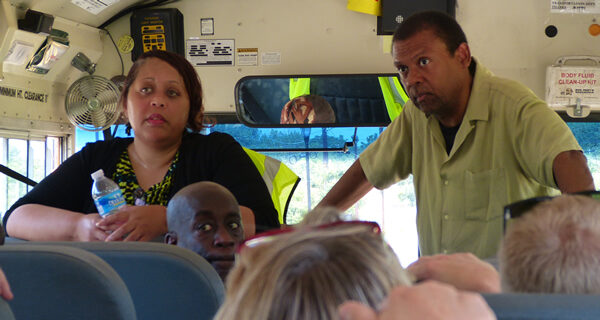Joni Sampson, president of the Eyes of Trenton Civic Association (pictured left) and Nicky Sheats, PhD., New Jersey Environmental Justice Alliance and Thomas Edison State College (pictured right) leading a bus tour as part of the Cumulative Impacts Workshop.
As we toured a neighborhood in East Trenton, I saw firsthand the destructive effects caused by environmental injustice.
New Jersey cities and towns have made hundreds of seemingly inconsequential decisions as they have grown over the last 100 years, which when added together are ruining the ecosystem and our communities. The children in the neighborhood we visited attend schools surrounded by industrial emitters of toxic and hazardous pollutants.
Polluting facilities and impacts are concentrated in neighborhoods where people of color and people of low-income live and in urban areas. This is unfair, unjust and entirely avoidable.
Cumulative Impacts Workshop
On July 12, Sustainable Jersey hosted a workshop led by the New Jersey Environmental Justice Alliance (NJEJA). NJEJA is an alliance of New Jersey-based organizations and individuals working together to identify, prevent, and reduce and/or eliminate environmental injustices that exist in communities of color and low-income.
Peter Montague, Ph.D., one of the workshop speakers, who’s active in NJEJA, set the stage. He pointed out that no one decision may cause environmental injustice to develop; instead it’s caused by decisions that are made without any one asking what the cumulative impact of making the change is, thus taking into consideration what’s already there.
Dr. Montague said, “As environmental degradation continues to get worse, it becomes more obvious that the environmental footprint of growth is now so dangerously large, that it only makes sense for everyone, and particularly our municipalities, to examine the effects of land use changes before they implement them. We need the context of what is already in an area to determine how a proposed change will impact our water, air and food.” Dr. Montague has advocated for these issues since 1970, when he spent his summer as a “Nader Raider” working with Ralph Nader to shape the modern activist movement and protect the environment. Forty-two years later, he has never looked back.
Dr. Montague joined with the Eyes of Trenton Civic Association and the NJEJA to oppose the expansion of a large waste recycling plant in East Trenton due to the fact that it was located in a community of predominately Black and Hispanic residents already overburdened with sources of pollution. The group has made videos that document this effort, including this video: Enough is Enough.
Joni Sampson, president of the Eyes of Trenton Civic Association led the workshop bus tour and explained the groups’ opposition to the waste recycling plant. Nicky Sheats, PhD., director of the Center for the Urban Environment at the John S. Watson Institute for Public Policy of Thomas Edison Sate College also presented at the workshop; he told the group that “the association between race, income and pollution in New Jersey that data seem to indicate, goes against everything we say we stand for in this state and is unacceptable. New Jersey and its citizens should take decisive action to address the state’s environmental justice problems.”
Two Recommended Actions for Municipalities
The Sustainable Jersey program includes Diversity and Equity actions that towns can do as part of the certification program. These actions include diversity on boards and commissions, environmental justice in zoning and planning and lead education and training programs. In addition, the workshop provided information on both environmental justice and cumulative impacts, and included a discussion of possible solutions for the problem of cumulative impacts in New Jersey. Two actions for municipalities were discussed and recommended:
1) Do a Natural Resource Inventory (NRI)
A town cannot adequately assess if a waste recycling facility will add a cumulative impact, for example, unless it knows what else is in the neighborhood. The Natural Resource Inventory (NRI), also known as an Environmental Resource Inventory (ERI), serves as an index of natural resources. It provides baseline documentation and is an important tool for environmental commissions, planning boards, and zoning boards of adjustment. A municipality will earn 20 points toward Sustainable Jersey certification for a Natural Resource Inventory completed in the last six years.
2) Require an Environmental Impact Study
An environmental impact study is an assessment of the possible positive or negative impacts that a proposed project may have on the environment, together consisting of the environmental, social and economic aspects. The purpose of the assessment is to ensure that decision makers consider the ensuing environmental impacts when deciding whether to proceed with a project.
Communities have long considered the environmental impacts of their planning and zoning decisions in their comprehensive planning programs. Yet few communities have considered the environmental justice consequences and opportunities that could be addressed and mitigated through comprehensive community planning programs. Strong leadership from both elected and appointed community leaders is vital to the success of this type of initiative. Fairfield Township in Essex County New Jersey has a local ordinance requiring an Environmental Impact Statement for new projects. The Fairfield ordinance is on the web here: http://goo.gl/lTJp4
Attend the Next Cumulative Impacts Workshop
Interested in learning more? Sustainable Jersey is planning a Cumulative Impacts Workshop in Camden, New Jersey in fall 2012. To find out about events, join the mailing list at www.SustainableJersey.com.
For more about Sustainable Jersey®:
Website | Facebook | Twitter
Image courtesy Sustainable Jersey
Sustainable Jersey staff and partners are regular contributors to the Dodge blog

